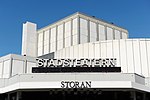Maria Station
1999 establishments in Sweden20th-century establishments in Skåne CountyBuildings and structures completed in 1999Railway stations in HelsingborgRailway stations in Sweden opened in the 1990s ... and 3 more
Railway stations on the West Coast Line (Sweden)Railway stations opened in 1999Swedish railway station stubs

Maria Station is a railway station for commuter trains located on the West Coast Line in the northern parts of Helsingborg, Sweden. The station was inaugurated in 1999 and currently consists of two platforms and two tracks. The local trains (Pågatåg) serve the station. It is one of three passenger railway stations located in the city of Helsingborg, along with Helsingborg C and Ramlösa Station, of which it is the northernmost situated railway station of the city.
Excerpt from the Wikipedia article Maria Station (License: CC BY-SA 3.0, Authors, Images).Maria Station
Maria Stationsgata, Helsingborg Mariastaden
Geographical coordinates (GPS) Address Nearby Places Show on map
Geographical coordinates (GPS)
| Latitude | Longitude |
|---|---|
| N 56.076388888889 ° | E 12.711111111111 ° |
Address
Maria Stationsgata
Maria Stationsgata
254 47 Helsingborg, Mariastaden
Sweden
Open on Google Maps









